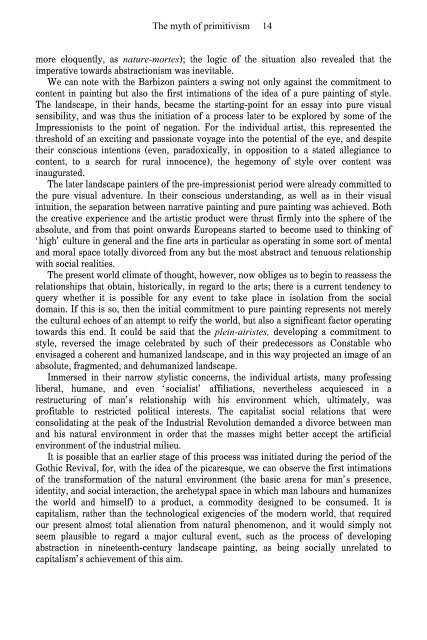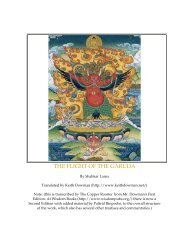Hiller - The Myth of Primitivism. Perspectives on Art - Esoteric Online
Hiller - The Myth of Primitivism. Perspectives on Art - Esoteric Online
Hiller - The Myth of Primitivism. Perspectives on Art - Esoteric Online
Create successful ePaper yourself
Turn your PDF publications into a flip-book with our unique Google optimized e-Paper software.
<str<strong>on</strong>g>The</str<strong>on</strong>g> myth <str<strong>on</strong>g>of</str<strong>on</strong>g> primitivism 14<br />
more eloquently, as nature-mortes); the logic <str<strong>on</strong>g>of</str<strong>on</strong>g> the situati<strong>on</strong> also revealed that the<br />
imperative towards abstracti<strong>on</strong>ism was inevitable.<br />
We can note with the Barbiz<strong>on</strong> painters a swing not <strong>on</strong>ly against the commitment to<br />
c<strong>on</strong>tent in painting but also the first intimati<strong>on</strong>s <str<strong>on</strong>g>of</str<strong>on</strong>g> the idea <str<strong>on</strong>g>of</str<strong>on</strong>g> a pure painting <str<strong>on</strong>g>of</str<strong>on</strong>g> style.<br />
<str<strong>on</strong>g>The</str<strong>on</strong>g> landscape, in their hands, became the starting-point for an essay into pure visual<br />
sensibility, and was thus the initiati<strong>on</strong> <str<strong>on</strong>g>of</str<strong>on</strong>g> a process later to be explored by some <str<strong>on</strong>g>of</str<strong>on</strong>g> the<br />
Impressi<strong>on</strong>ists to the point <str<strong>on</strong>g>of</str<strong>on</strong>g> negati<strong>on</strong>. For the individual artist, this represented the<br />
threshold <str<strong>on</strong>g>of</str<strong>on</strong>g> an exciting and passi<strong>on</strong>ate voyage into the potential <str<strong>on</strong>g>of</str<strong>on</strong>g> the eye, and despite<br />
their c<strong>on</strong>scious intenti<strong>on</strong>s (even, paradoxically, in oppositi<strong>on</strong> to a stated allegiance to<br />
c<strong>on</strong>tent, to a search for rural innocence), the hegem<strong>on</strong>y <str<strong>on</strong>g>of</str<strong>on</strong>g> style over c<strong>on</strong>tent was<br />
inaugurated.<br />
<str<strong>on</strong>g>The</str<strong>on</strong>g> later landscape painters <str<strong>on</strong>g>of</str<strong>on</strong>g> the pre-impressi<strong>on</strong>ist period were already committed to<br />
the pure visual adventure. In their c<strong>on</strong>scious understanding, as well as in their visual<br />
intuiti<strong>on</strong>, the separati<strong>on</strong> between narrative painting and pure painting was achieved. Both<br />
the creative experience and the artistic product were thrust firmly into the sphere <str<strong>on</strong>g>of</str<strong>on</strong>g> the<br />
absolute, and from that point <strong>on</strong>wards Europeans started to become used to thinking <str<strong>on</strong>g>of</str<strong>on</strong>g><br />
‘high’ culture in general and the fine arts in particular as operating in some sort <str<strong>on</strong>g>of</str<strong>on</strong>g> mental<br />
and moral space totally divorced from any but the most abstract and tenuous relati<strong>on</strong>ship<br />
with social realities.<br />
<str<strong>on</strong>g>The</str<strong>on</strong>g> present world climate <str<strong>on</strong>g>of</str<strong>on</strong>g> thought, however, now obliges us to begin to reassess the<br />
relati<strong>on</strong>ships that obtain, historically, in regard to the arts; there is a current tendency to<br />
query whether it is possible for any event to take place in isolati<strong>on</strong> from the social<br />
domain. If this is so, then the initial commitment to pure painting represents not merely<br />
the cultural echoes <str<strong>on</strong>g>of</str<strong>on</strong>g> an attempt to reify the world, but also a significant factor operating<br />
towards this end. It could be said that the plein-airistes, developing a commitment to<br />
style, reversed the image celebrated by such <str<strong>on</strong>g>of</str<strong>on</strong>g> their predecessors as C<strong>on</strong>stable who<br />
envisaged a coherent and humanized landscape, and in this way projected an image <str<strong>on</strong>g>of</str<strong>on</strong>g> an<br />
absolute, fragmented, and dehumanized landscape.<br />
Immersed in their narrow stylistic c<strong>on</strong>cerns, the individual artists, many pr<str<strong>on</strong>g>of</str<strong>on</strong>g>essing<br />
liberal, humane, and even ‘socialist’ affiliati<strong>on</strong>s, nevertheless acquiesced in a<br />
restructuring <str<strong>on</strong>g>of</str<strong>on</strong>g> man’s relati<strong>on</strong>ship with his envir<strong>on</strong>ment which, ultimately, was<br />
pr<str<strong>on</strong>g>of</str<strong>on</strong>g>itable to restricted political interests. <str<strong>on</strong>g>The</str<strong>on</strong>g> capitalist social relati<strong>on</strong>s that were<br />
c<strong>on</strong>solidating at the peak <str<strong>on</strong>g>of</str<strong>on</strong>g> the Industrial Revoluti<strong>on</strong> demanded a divorce between man<br />
and his natural envir<strong>on</strong>ment in order that the masses might better accept the artificial<br />
envir<strong>on</strong>ment <str<strong>on</strong>g>of</str<strong>on</strong>g> the industrial milieu.<br />
It is possible that an earlier stage <str<strong>on</strong>g>of</str<strong>on</strong>g> this process was initiated during the period <str<strong>on</strong>g>of</str<strong>on</strong>g> the<br />
Gothic Revival, for, with the idea <str<strong>on</strong>g>of</str<strong>on</strong>g> the picaresque, we can observe the first intimati<strong>on</strong>s<br />
<str<strong>on</strong>g>of</str<strong>on</strong>g> the transformati<strong>on</strong> <str<strong>on</strong>g>of</str<strong>on</strong>g> the natural envir<strong>on</strong>ment (the basic arena for man’s presence,<br />
identity, and social interacti<strong>on</strong>, the archetypal space in which man labours and humanizes<br />
the world and himself) to a product, a commodity designed to be c<strong>on</strong>sumed. It is<br />
capitalism, rather than the technological exigencies <str<strong>on</strong>g>of</str<strong>on</strong>g> the modern world, that required<br />
our present almost total alienati<strong>on</strong> from natural phenomen<strong>on</strong>, and it would simply not<br />
seem plausible to regard a major cultural event, such as the process <str<strong>on</strong>g>of</str<strong>on</strong>g> developing<br />
abstracti<strong>on</strong> in nineteenth-century landscape painting, as being socially unrelated to<br />
capitalism’s achievement <str<strong>on</strong>g>of</str<strong>on</strong>g> this aim.




